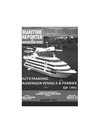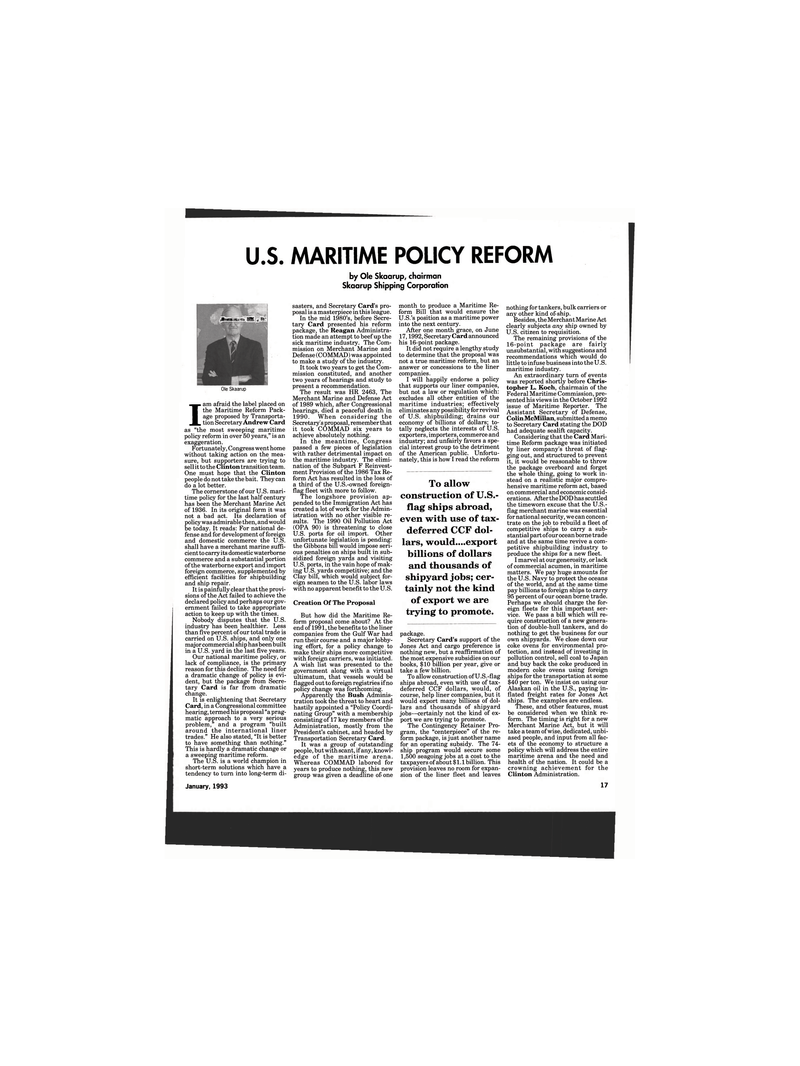
Page 15: of Maritime Reporter Magazine (January 1993)
Read this page in Pdf, Flash or Html5 edition of January 1993 Maritime Reporter Magazine
U.S. MARITIME POLICY REFORM by Ole Skaarup, chairman
Skaarup Shipping Corporation tLi •HfS.i:
Ole Skaarup
I am afraid the label placed on the Maritime Reform Pack- age proposed by Transporta- tion Secretary Andrew Card as "the most sweeping maritime policy reform in over 50 years," is an exaggeration.
Fortunately, Congress went home without taking action on the mea- sure, but supporters are trying to sell it to the Clinton transition team.
One must hope that the Clinton people do not take the bait. They can do a lot better.
The cornerstone of our U.S. mari- time policy for the last half century has been the Merchant Marine Act of 1936. In its original form it was not a bad act. Its declaration of policy was admirable then, and would be today. It reads: For national de- fense and for development of foreign and domestic commerce the U.S. shall have a merchant marine suffi- cient to carry its domestic waterborne commerce and a substantial portion of the waterborne export and import foreign commerce, supplemented by efficient facilities for shipbuilding and ship repair.
It is painfully clear that the provi- sions of the Act failed to achieve the declared policy and perhaps our gov- ernment failed to take appropriate action to keep up with the times.
Nobody disputes that the U.S. industry has been healthier. Less than five percent of our total trade is carried on U.S. ships, and only one major commercial ship has been built in a U.S. yard in the last five years.
Our national maritime policy, or lack of compliance, is the primary reason for this decline. The need for a dramatic change of policy is evi- dent, but the package from Secre- tary Card is far from dramatic change.
It is enlightening that Secretary
Card, in a Congressional committee hearing, termed his proposal "a prag- matic approach to a very serious problem," and a program "built around the international liner trades." He also stated, "It is better to have something than nothing."
This is hardly a dramatic change or a sweeping maritime reform.
The U.S. is a world champion in short-term solutions which have a tendency to turn into long-term di-
January, 1993 sasters, and Secretary Card's pro- posal is a masterpiece in this league.
In the mid 1980's, before Secre- tary Card presented his reform package, the Reagan Administra- tion made an attempt to beef up the sick maritime industry. The Com- mission on Merchant Marine and
Defense (COMMAD) was appointed to make a study of the industry.
It took two years to get the Com- mission constituted, and another two years of hearings and study to present a recommendation.
The result was HR 2463, The
Merchant Marine and Defense Act of 1989 which, after Congressional hearings, died a peaceful death in 1990. When considering the
Secretary's proposal, remember that it took COMMAD six years to achieve absolutely nothing.
In the meantime, Congress passed a few pieces of legislation with rather detrimental impact on the maritime industry. The elimi- nation of the Subpart F Reinvest- ment Provision of the 1986 Tax Re- form Act has resulted in the loss of a third of the U.S.-owned foreign- flag fleet with more to follow.
The longshore provision ap- pended to the Immigration Act has created a lot of work for the Admin- istration with no other visible re- sults. The 1990 Oil Pollution Act (OPA 90) is threatening to close
U.S. ports for oil import. Other unfortunate legislation is pending: the Gibbons bill would impose seri- ous penalties on ships built in sub- sidized foreign yards and visiting
U.S. ports, in the vain hope of mak- ing U.S. yards competitive; and the
Clay bill, which would subject for- eign seamen to the U.S. labor laws with no apparent benefit to the U.S.
Creation Of The Proposal
But how did the Maritime Re- form proposal come about? At the end of 1991, the benefits to the liner companies from the Gulf War had run their course and a major lobby- ing effort, for a policy change to make their ships more competitive with foreign carriers, was initiated.
A wish list was presented to the government along with a virtual ultimatum, that vessels would be flagged out to foreign registries if no policy change was forthcoming.
Apparently the Bush Adminis- tration took the threat to heart and hastily appointed a "Policy Coordi- nating Group" with a membership consisting of 17 key members of the
Administration, mostly from the
President's cabinet, and headed by
Transportation Secretary Card.
It was a group of outstanding people, but with scant, if any, knowl- edge of the maritime arena.
Whereas COMMAD labored for years to produce nothing, this new group was given a deadline of one month to produce a Maritime Re- form Bill that would ensure the
U.S.'s position as a maritime power into the next century.
After one month grace, on June 17,1992, Secretary Card announced his 16-point package.
It did not require a lengthy study to determine that the proposal was not a true maritime reform, but an answer or concessions to the liner companies.
I will happily endorse a policy that supports our liner companies, but not a law or regulation which: excludes all other entities of the maritime industries; effectively eliminates any possibility for revival of U.S. shipbuilding; drains our economy of billions of dollars; to- tally neglects the interests of U.S. exporters, importers, commerce and industry; and unfairly favors a spe- cial interest group to the detriment of the American public. Unfortu- nately, this is how I read the reform
To allow construction of U.S.- flag ships abroad, even with use of tax- deferred CCF dol- lars, would....export billions of dollars and thousands of shipyard jobs; cer- tainly not the kind of export we are trying to promote. package.
Secretary Card's support of the
Jones Act and cargo preference is nothing new, but a reaffirmation of the most expensive subsidies on our books, $10 billion per year, give or take a few billion.
To allow construction of U.S.-flag ships abroad, even with use of tax- deferred CCF dollars, would, of course, help liner companies, but it would export many billions of dol- lars and thousands of shipyard jobs—certainly not the kind of ex- port we are trying to promote.
The Contingency Retainer Pro- gram, the "centerpiece" of the re- form package, is just another name for an operating subsidy. The 74- ship program would secure some 1,500 seagoing jobs at a cost to the taxpayers of about $1.1 billion. This provision leaves no room for expan- sion of the liner fleet and leaves nothing for tankers, bulk carriers or any other kind of ship.
Besides, the Merchant Marine Act clearly subjects any ship owned by
U.S. citizen to requisition.
The remaining provisions of the 16-point package are fairly unsubstantial, with suggestions and recommendations which would do little to infuse business into the U.S. maritime industry.
An extraordinary turn of events was reported shortly before Chris- topher L. Koch, chairmain of the
Federal Maritime Commission, pre- sented his views in the October 1992 issue of Maritime Reporter. The
Assistant Secretary of Defense,
Colin McMillan, submitted a memo to Secretary Card stating the DOD had adequate sealift capacity.
Considering that the Card Mari- time Reform package was initiated by liner company's threat of flag- ging out, and structured to prevent it, it would be reasonable to throw the package overboard and forget the whole thing, going to work in- stead on a realistic major compre- hensive maritime reform act, based on commercial and economic consid- erations. After the DOD has scuttled the timeworn excuse that the U.S.- flag merchant marine was essential for national security, we can concen- trate on the job to rebuild a fleet of competitive ships to carry a sub- stantial part of our ocean borne trade and at the same time revive a com- petitive shipbuilding industry to produce the ships for a new fleet.
I marvel at our generosity, or lack of commercial acumen, in maritime matters. We pay huge amounts for the U.S. Navy to protect the oceans of the world, and at the same time pay billions to foreign ships to carry 95 percent of our ocean borne trade.
Perhaps we should charge the for- eign fleets for this important ser- vice. We pass a bill which will re- quire construction of a new genera- tion of double-hull tankers, and do nothing to get the business for our own shipyards. We close down our coke ovens for environmental pro- tection, and instead of investing in pollution control, sell coal to Japan and buy back the coke produced in modern coke ovens using foreign ships for the transportation at some $40 per ton. We insist on using our
Alaskan oil in the U.S., paying in- flated freight rates for Jones Act ships. The examples are endless.
These, and other features, must be considered when we think re- form. The timing is right for a new
Merchant Marine Act, but it will take a team of wise, dedicated, unbi- ased people, and input from all fac- ets of the economy to structure a policy which will address the entire maritime arena and the need and health of the nation. It could be a crowning achievement for the
Clinton Administration. 17

 14
14

 16
16
